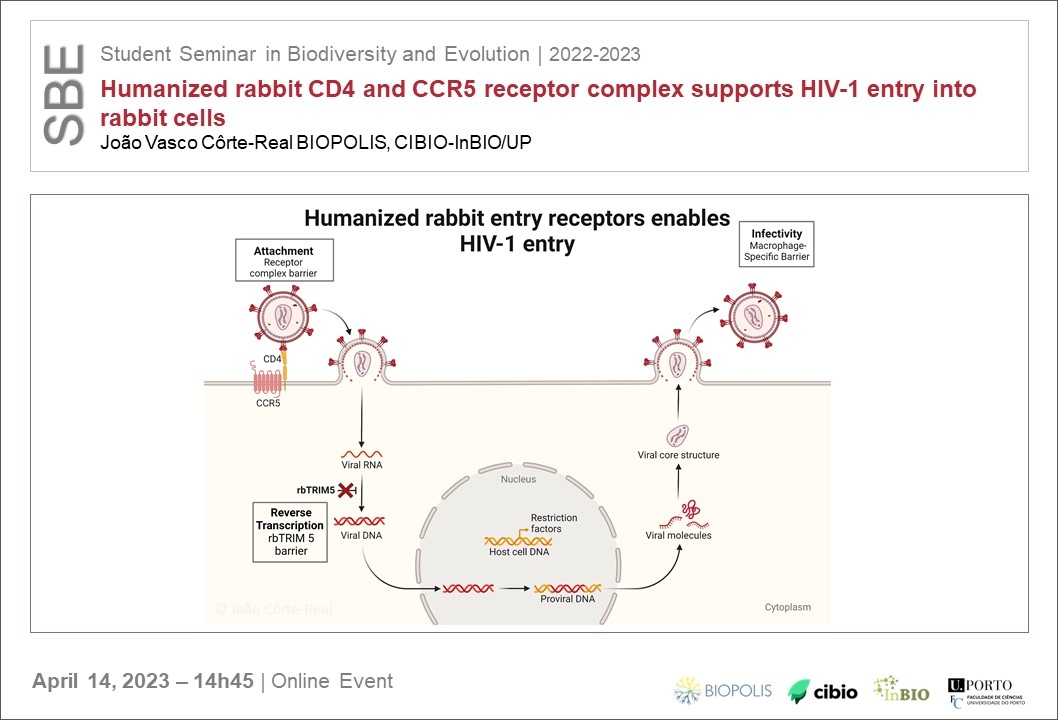Humanized rabbit CD4 and CCR5 receptor complex supports HIV-1 entry into rabbit cells
Event
Rabbits are being explored as potential model species for HIV-1 since rabbit cells display only few replication barriers to this virus: 1- they are not permissive to virus entry, 2- rabbit TRIM5 blocks HIV-1 reverse transcription, and 3- a primary rabbit macrophage-specific barrier reduces virion infectivity by a yet unknown mechanism. In light of generating a transgenic rabbit model that supports HIV-1 infection, our goal was to investigate whether minimal modifications to rabbit CD4 and CCR5 were sufficient to overcome the first barrier and thus enable HIV-1 entry into rabbit cells. Additionally, we examined whether these modifications altered the physiological functions of the receptors. Computational modeling and evolutionary analyses of rabbit CD4 and CCR5 protein sequences identified amino acid residues in both receptors that are predicted to prevent HIV-1 entry into rabbit cells. Based on these in silico analyses, we generated a set of seven human-rabbit CD4 and CCR5 chimeras via site-directed mutagenesis and compared them to the respective wild-type proteins. Flow cytometry and immunofluorescence experiments confirmed that all chimeras were localized at the cell surface. Furthermore, all CD4 chimeras were down-modulated by HIV-1 Nef and Vpu by more than 55% and 70%, respectively. Fusion assays with humanized rabbit CD4 and CCR5 supported virion fusion of different HIV-1 strains as efficiently as the human HIV entry receptor complex. Furthermore, we performed infection assay in rabbit cell line expressing the combination of humanized entry receptors which allowed infection by HIV-1 at day 3 to similar extent to human receptor complex control. In summary, computational modeling allowed us to identify restrictions to HIV-1 entry into rabbit cells that could be overcome by mutagenesis of CD4 and CCR5. Thus, our findings contribute to the development of a fully permissive transgenic rabbit model for HIV-1 infection.
June 28th, 2024
João Vasco Côrte-Real, BIOPOLIS, CIBIO-InBIO/UP | 14h45 | Hybrid Seminar (FCUP and Online)

Rabbits are being explored as potential model species for HIV-1 since rabbit cells display only few replication barriers to this virus: 1- they are not permissive to virus entry, 2- rabbit TRIM5 blocks HIV-1 reverse transcription, and 3- a primary rabbit macrophage-specific barrier reduces virion infectivity by a yet unknown mechanism. In light of generating a transgenic rabbit model that supports HIV-1 infection, our goal was to investigate whether minimal modifications to rabbit CD4 and CCR5 were sufficient to overcome the first barrier and thus enable HIV-1 entry into rabbit cells. Additionally, we examined whether these modifications altered the physiological functions of the receptors. Computational modeling and evolutionary analyses of rabbit CD4 and CCR5 protein sequences identified amino acid residues in both receptors that are predicted to prevent HIV-1 entry into rabbit cells. Based on these in silico analyses, we generated a set of seven human-rabbit CD4 and CCR5 chimeras via site-directed mutagenesis and compared them to the respective wild-type proteins. Flow cytometry and immunofluorescence experiments confirmed that all chimeras were localized at the cell surface. Furthermore, all CD4 chimeras were down-modulated by HIV-1 Nef and Vpu by more than 55% and 70%, respectively. Fusion assays with humanized rabbit CD4 and CCR5 supported virion fusion of different HIV-1 strains as efficiently as the human HIV entry receptor complex. Furthermore, we performed infection assay in rabbit cell line expressing the combination of humanized entry receptors which allowed infection by HIV-1 at day 3 to similar extent to human receptor complex control. In summary, computational modeling allowed us to identify restrictions to HIV-1 entry into rabbit cells that could be overcome by mutagenesis of CD4 and CCR5. Thus, our findings contribute to the development of a fully permissive transgenic rabbit model for HIV-1 infection.
João Vasco Côrte-Real completed his Master's degree in Molecular and Cellular Biology from the University of Porto. During the Master's, he became interested in immunology and host-pathogen interaction. Currently, he is in the 4th year of his PhD in the BIODIV doctoral program, been developed at IMED group, under the supervision of Joana Abrantes and Hanna-Mari Baldauf from the Max von Pettenkofer Institute (Munich). One of the main focus of his PhD thesis is to use the European rabbit as an animal model to study HIV-1. Additionally, he is also interested in the evolution of antiviral proteins (e.g. GBPs, TRIM and MARCH).
[Host: Joana Abrantes, Immunity and Emerging Diseases - IMED]
